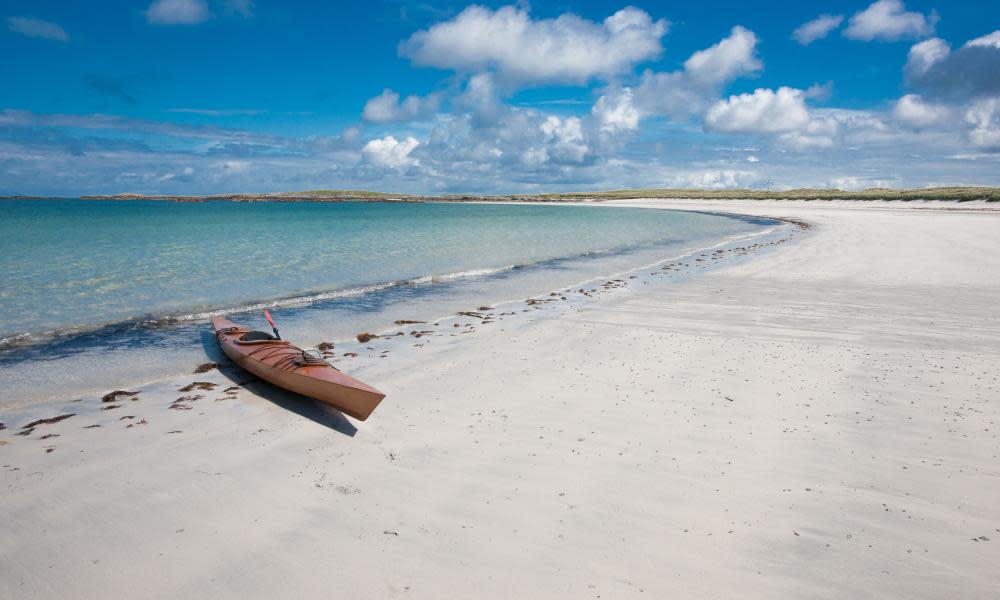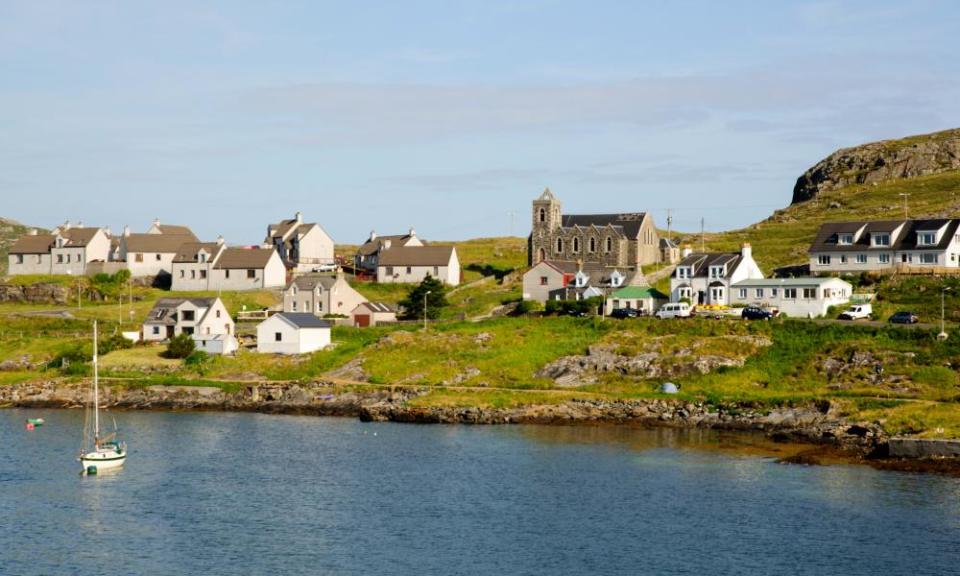Songs, stories and sea kayaking: a writer returns to the Outer Hebrides

One reason that I love going to Howmore in South Uist – the second-largest island of Scotland’s Outer Hebrides – is that it reminds me of aspects of my childhood. Growing up in my home village in Ness near the Butt of Lewis at the northern tip of the Western Isles (the other name for these islands), there were always several thatched buildings nearby, the occasional home but more frequently barns and byres, all roofed with straw harvested from local crofts. These still exist in Howmore. During one of the first occasions I travelled there, I saw a group of men led by famed sea kayaker Brian Wilson thatching the roof of the youth hostel within the community, standing on the edge of the building’s whitewashed walls as they laid – unusually – each strand of heather perfectly in place.
There was much else that was wondrous about that community. Together with these old structures, there was an array of churches. Among the latter is the east gable of Teampull Mor or the “large church” – or St Mary’s – a ruin dating back, it is said, to the 13th century. Not far from it stands another church, one of the few Protestant kirks in South Uist’s largely Catholic community.
And all around them is a different type of music from the sacred hymns and psalms that often emanated from these buildings. Circling are the songs of birds, such as lapwings, curlews, the croaking voices of corncrakes, oystercatchers rising from the stretch of sand that loops around much of South Uist’s shoreline. There could be heard, too, the melody of the song-thrush or smeòrach in the stillness of the day, its lilt and rhythms imitated by one of the Gaelic songs I learned years before in primary school: Tha Smeòrach sa Mhadainn Chiùin – The Thrush on a Calm Morning.

It acts as just one reminder of how much is Gaelic about Howmore and its surroundings. Down the road in Daliburgh near the island’s southern end, a new Gaelic centre called Cnoc Soilleir – or the Hill of Light – is coming into existence, a venue for Gaelic both spoken and sung. Together with celebrating a language that is still heard throughout much of the Outer Hebrides, it is also intent on reviving a style of music and dance that was an inherent and distinctive part of the community of South Uist for centuries. The group Ceolas Uibhist has been involved in this, bringing singers and musicians from Cape Breton – where that tradition was preserved – to help them in this task.
A few short miles away, too, is the childhood home of one of Gaelic poetry’s finest contemporary voices, Angus Peter Campbell, whose work often extolls and praises the landscape of his native island. Nearby in the village of Milton, there is a memorial to a hero of Scotland’s past, Flora MacDonald, famous for having assisted in the escape of Prince Charles Edward Stuart after the Jacobite uprising and the Battle of Culloden in 1746. She is the one immortalised in the song Speed Bonnie Boat, with its threat of thunderclaps rending the air.
There were no signs of these during the days I wandered through Howmore. Instead I would look up to the high hills that bordered the eastern edge of the village. There were solitary birds there too, buzzards, eagles and hen harriers winging their way around the crests of both Hecla and Beinn Mhòr, its very name revealing it is the highest peak in South Uist. Back on earlier visits, my children would look at these slopes as impossible barriers, much too high for them to climb.
Over the last few years, my son Angus has discovered a different way of overcoming these obstacles. Having taken up kayaking as a child in the sheltered sea lochs of North and South Uist, he now often travels through parts of the Western Isles that would have been difficult for previous generations to explore, pointing out that it’s often the easiest way of getting from one place to another in these parts.

Even his recent experiences underline the truth of these words. He has visited Taransay, off the west coast of Harris and, leaving Stornoway with its much loved arts and cultural hub, An Lanntair, to visit the Shiant Isles off its eastern edge. He was guided there by the gleam of Tiumpan Head lighthouse on the peninsula of Point, built by the Stevenson family, one of whose kin was, of course, Robert Louis Stevenson, a central figure in Scotland’s Year of Stories 2022.
It is not the only literary location that my son has discovered while kayaking. He has circled Raasay off Skye, which was the childhood home of the Gaelic poet Sorley Maclean, who was inspired to write his most famous poem, Hallaig, after witnessing the deer grazing within the island’s woods. He has paddled between Harris and North Uist, the latter the location where Donald Macdonald or Dòmhnall Ruadh Chorùna (Red Donald of Corunna) recalled An Eala Bhàn (The White Swan) coasting on the surface of one of the island’s many lochs. Regarded as the most beautiful Gaelic song of the 20th century, he wrote this while fighting at the Battle of the Somme, recalling his native island’s “mist-veiled hills” and “its glens echoing love-songs” in that grim and bitter landscape.

Yet there is much more that Angus still wishes to explore, especially at the southern end of the Inner Hebrides. He hopes to visit the grandeur of Fingal’s Cave in Staffa, a location that inspired both Mendelssohn and Wordsworth, and to take his kayak around the coastline of Tiree, an island which was the home of many of both his and my ancestors. Nowadays the island is known as one of the best locations in the country for board-surfing and kite-surfing, with residents and visitors alike making use of the high winds and waves to be found there.
“I’ve walked around the glorious beaches there,” my son says. “But I would really like to kayak out to Skerryvore, the magnificent lighthouse close to its shores.”
A Gaelic speaker from Ness, Isle of Lewis, Donald S Murray’s most recent books are For the Safety of All – A Story of Scotland’s Lighthouses (HES) and In a Veil of Mist (Saraband). A previous novel was As the Women Lay Dreaming (Saraband), inspired by the effects of the Iolaire disaster of 1st January 1919 on the island of Lewis. This last novel won the Paul Torday Memorial Prize for 2020.
Scotland’s Year of Stories 2022 spotlights, celebrates and promotes the wealth of stories inspired by, written, or created in Scotland. More info on the programme can be found here
To explore the accessible Outer Hebrides, plan your break in advance and find out more at visitscotland.com/destinations-maps/outer-hebrides


